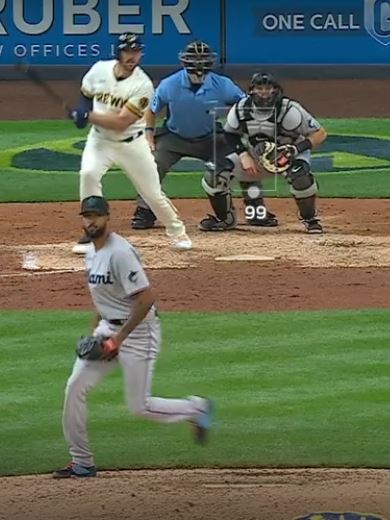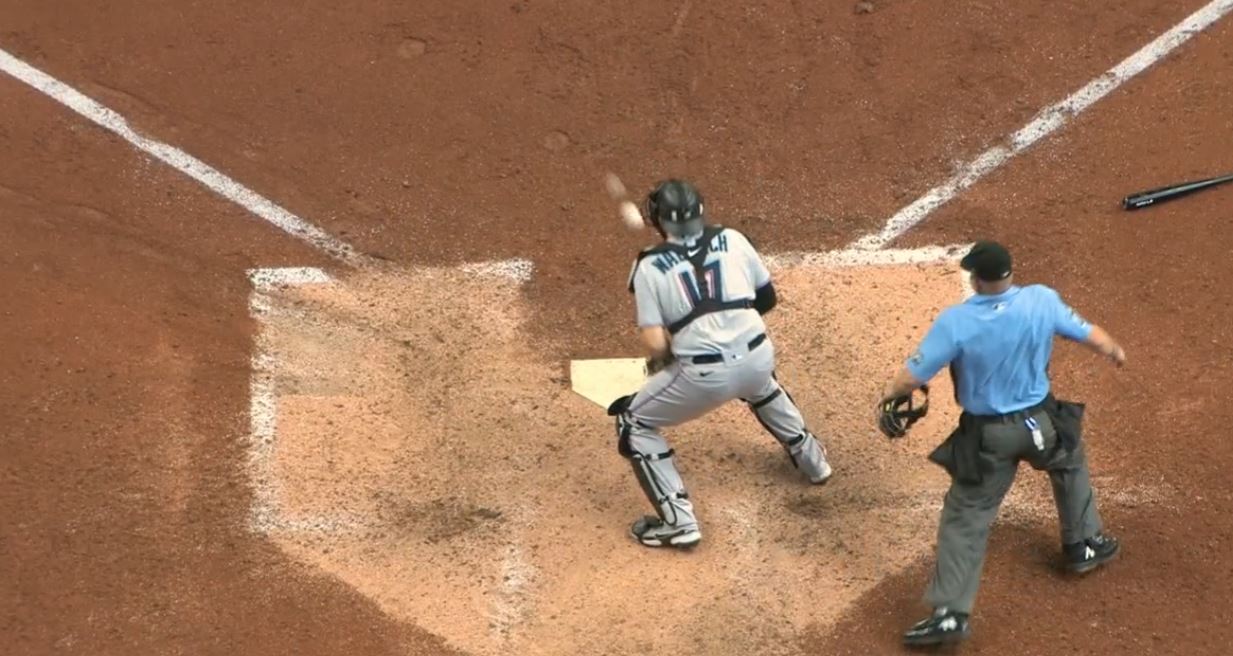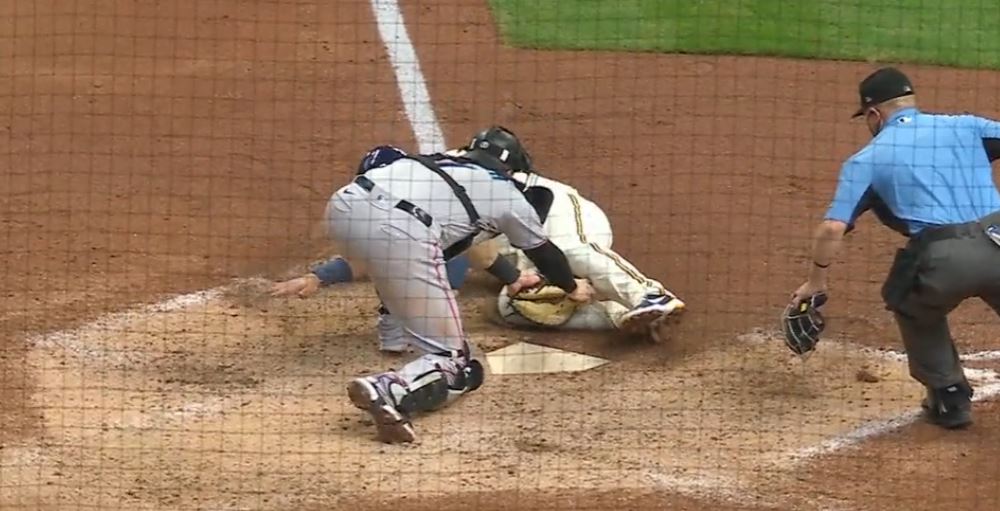One Double Play, Examined
Wednesday night, the Marlins defeated the Brewers by a comfortable 6-2 margin. Though the game wasn’t close, it could have been slightly closer: the Marlins saved a run with a clutch sacrifice fly double play in the bottom of the sixth. That’s a standard play; every level from youth tee ball on up has catch-and-throw double plays. That doesn’t mean it wasn’t impressive. In fact, the moment-to-moment action of the play shows how impressive baseball players are even on plays we think of as de rigueur.
Here, watch it in real time:
Let’s start with the pitch: Sandy Alcantara couldn’t have done much better. He dotted the bottom of the zone with a 99 mph sinker, the perfect location to induce an inning-ending ground ball. Seriously, it’s hard to draw it up any better than this:

That’s a perfect location for a grounder-inducing pitch. When he’s located that pitch on the bottom edge of the zone, good things have happened: he’s saved roughly four runs relative to average per 100 sinkers he’s located there. That’s roughly in line with the best overall pitches in baseball. When he spots it, in other words, the Marlins are right where they want to be.
Travis Shaw begged to differ. Well-spotted pitch, plus velocity: he hit the smithereens out of it. The ball came off his bat at 101.7 mph, a veritable laser beam. Combined with its flat 12 degree launch angle, that ball is a hit the vast majority of the time; it carried a .910 expected batting average per Statcast, though that ignores the horizontal angle (or spray angle), and Shaw happened to hit it right at a defender.
So far, this play had been a chain of each team outdoing its opponent’s previous move. Alcantara placed a fastball perfectly. Shaw hit the snot out of it. Lewis Brinson had it shaded perfectly — and to be fair, he didn’t have to do much to make the catch given where Shaw hit it.
From there, however, every split second was of the utmost importance. Shaw hit that ball so hard that even without much loft, it carried 287 feet. That’s plenty deep; there have been 485 sacrifice fly situations in the last two years where the ball was hit 285 feet or farther and caught in the air, and 97% of them scored the runner on third.
Of course, “the runner on third” isn’t an abstract concept. In this case, it was Daniel Vogelbach, and he’s nearly the worst position player the Brewers could have asked for in this particular situation. He’s a lovable Large Adult Son, but he’s not fleet of foot by major league standards. In 2020, he averaged 4.52 seconds on his 90-foot running splits, 357th out of 362 qualifying runners.
That’s still reasonably fast in regular human terms, but it made a play at least possible. If teammate Kolten Wong had been on third instead, his 3.99 second split would give Brinson a half-second less to get the ball home; that’s a huge difference on a play where everything needs to go perfectly to succeed. Even then, though, it’s only a half second; the difference between bad and good runners just isn’t that much. Say the word “spaghetti” out loud — that was more time than the difference between Wong and Vogelbach’s third-to-home times.
As it transpired, Vogelbach beat his average. He clocked in at roughly 4.35 seconds, a number I reached with a stopwatch and a ton of repetitions. That’s exactly the max-effort run you’d expect on a borderline sacrifice fly opportunity; it was clear the play would be a close call, and Vogelbach rose to the occasion.
Also rising to the occasion? Brinson. The math is rough on Brinson here; per research from Tom Tango, I used an estimate of 1.2 seconds for Brinson’s transfer and catcher Chad Wallach’s catch and tag. That leaves 3.15 seconds to get the ball from deep left field to the plate, with the added requirement that it be in Wallach’s catch radius.
From that same excellent Tango article, I used his average outfielder arm estimate and converted that to time from throw to the plate. As it turns out, throwing the ball at 85 mph from 287 feet gets the ball to home plate in 3.15 seconds — exactly how much time he had to make the play. Assuming an average arm and perfect accuracy, Vogelbach’s extra bit of speed turned this play from a likely out to a coin flip.
An average arm is a poor assumption to make when it comes to Brinson, though. While his accuracy remains an open question, scouts have consistently given him high marks for his arm strength, and he can air it out with the best of them. On this play, he also had a running start due to deep positioning, which gave him a further tailwind. From release until the ball reached Wallach, I clocked his throw at roughly 2.8 seconds, which equates to 96 mph (!!) out of his hand. That’s an absolute cannon of a throw, and while some skepticism is merited given the way I calculated it, Statcast clocked it at 95.5 mph. Brinson just played it perfectly:
While his throw was an absolute missile, the crow hop that Brinson used to power up cost him some of those precious fractions of a second he gained with the throw. The ball hit Wallach in the chest 3.85 seconds after Brinson caught it, which gave the catcher half a second to kill the ball’s momentum, gather himself, and apply a tag. Again, say “spaghetti” out loud — that’s how much time he had for this multi-stage maneuver. This isn’t an easy place to start your catch:

Vogelbach is out of frame, but only barely. By the time Wallach got both hands on it, time was running short. Here’s another angle of it (sorry about the umpire):

Okay. Large man bearing down on you at great speed, laser beam of a baseball catching you high in the chest — it’s time for the instincts to kick in. Wallach did what came naturally; he stabbed with his glove at the front of the plate, the point Vogelbach was most likely to cross through on his path to safety. He just managed it. As best as I can tell, here’s the moment his glove hit Vogelbach’s leg:

Figuring out distance on a broadcast is difficult, but that’s a matter of inches, not feet. The slightest bobble by Wallach, any miscue by Brinson, and Vogelbach would have scored. A better slide might have done it, but he’s hardly renowned for his sliding, and he had already done his part to ensure his safety by booking it down the line. He was caught in between on his slide, and if he’d managed to stick his foot out slightly differently, who knows:
This wasn’t a tremendously consequential play. If the run had scored, the Brewers would have trialed by three, and they managed a whopping two hits the rest of the way, so they were hardly tearing the cover off the ball. It would be easy to gloss over it, to think “good outfielder got slow runner” and move on with your life.
That’s not what happened, or at least it’s an insufficient description. Everyone did their job at a high level. Alcantara executed his pitch. Shaw tattooed it. Brinson was positioned perfectly, then unleashed a hellacious and accurate throw. He had to, because Vogelbach booked it down the line. Wallach made a split-second gather look easy and applied a tag with inches to spare. The only hiccup the whole way was Vogelbach’s slide, and that one tiny blemish was the difference between safe and out.
Regular baseball plays, the kind that don’t even make highlight reels unless they change the outcome of a game, aren’t routine. They’re routine in the major leagues, sure. That’s only the case because these players are absurdly good. The pitchers are nasty, the hitters crush baseballs. The outfielders throw 280 feet and hit their target in the chest. The catchers have split-second reflexes. Even the big men fly down the line when they need to. Baseball is beautiful, and even an out in a lopsided game can show how.
Ben is a writer at FanGraphs. He can be found on Bluesky @benclemens.

That was a hell of an article. Ben Clemens did his job at a high level here.
Regular articles, the kind that don’t even make end-of-year best-of lists unless they change the success of a website, aren’t routine. They’re routine in Fangraphs, sure. That’s only the case because these writers are absurdly good. The metaphors are clean, the rhetoric spotless. The analysis is mathematically precise and the assumptions crystal-clear. The prose has split-second cadence. Even the quantitative analysts can turn a phrase when they need to. Baseball writing is beautiful, and even an article about an out in a lopsided game can show how.